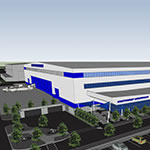Five years ago, defense contractor Northrop Grumman set a goal to reduce greenhouse gas emissions by 25 percent over five years. In 2012, two years ahead of schedule, it exceeded that goal. Today, the company continues its commitment to sustainable development with the LEED-certified St. Augustine Aircraft Integration Center of Excellence, a manufacturing facility for the E-2D Advanced Hawkeye aircraft.
The Florida facility, currently under construction by California-based The Austin Company, sprawls more than 368,000 square feet, and the site also hosts a taxiway for newly constructed aircraft. Both the size and function of the facility posed unique challenges to obtaining LEED certification. “LEED New Construction has a tendency to be based on smaller office buildings, which have narrow, rectangular building footprints,” says Kenric Stone, vice president at The Austin Company. “Manufacturing buildings are generally large cubes with open manufacturing floors and exposed structural steel. This type of building doesn’t fit the typical LEED office building footprint.”
Nevertheless, innovative solutions abound at the St. Augustine Center of Excellence. A high standard of air quality is maintained, despite the presence of indoor welding and construction. Extra intakes filter the air faster and more often, removing harmful particles and gases. Florida’s infamous humidity is kept in check by a chilled-water air-conditioning system, and solar power is generated via a film applied directly onto the insulated metal-panel roof. Low-flow shower stalls are available for employees who bike to work, while electric vehicle-charging stations are accessible to those who drive.
The site also incorporates elements of Florida’s natural environment. When the original blueprints called for part of the structure and taxiway to encroach on existing wetlands, Northrop Grumman challenged the St. Augustine design team to generate an alternative solution. They did, and the preserved wetlands and trees are now affectionately referred to as “the jungle.” Besides adding natural beauty, the wetlands also function as part of the site’s drainage system. Combined with a newly constructed retention pond, these ecological systems provide irrigation to the building’s native landscaping.
Northrop Grumman has projects underway at four other Centers of Excellence, including an engineering center in Melbourne, FL, which will support St. Augustine.
“We’re looking to enforce the company’s commitment to protect and safeguard the environment and our natural resources,” says Bill Trillo, Northrop Grumman’s director of facilities. “What we’re doing today—these will be structures that will last 40 to 50 years, and we want them to do so in the most environmentally friendly and efficient manner.”

